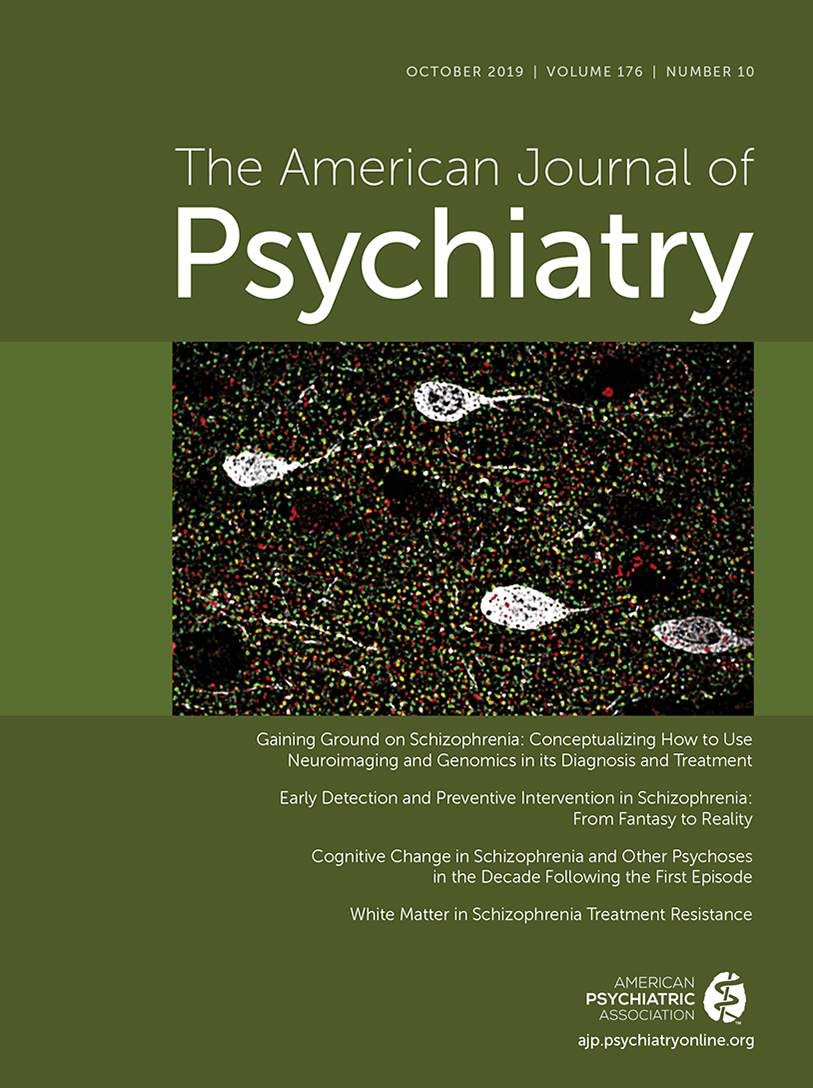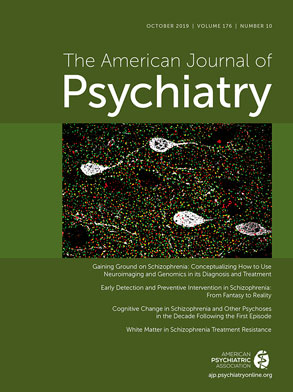Schizophrenia affects approximately 1% of the population and is among the most devastating and costly illnesses that we deal with in medicine. With its onset in the late teenage years and early adulthood, schizophrenia’s damaging effects begin during a period that should be the most vigorous, exciting, and formative years of an adult’s life. Schizophrenia is a highly heritable disorder, and despite current treatments, most patients have a chronic course resulting in marked lifelong functional disability. The illness is characterized by positive symptoms (e.g., hallucinations and delusions), negative symptoms (e.g., blunted affect and decreased motivation), and alterations in cognition (e.g., working memory and executive function). Not surprisingly, schizophrenia also has alarming consequences for general medical health, with an increased mortality rate 3.5 times that of the general population (
1) and a decreased lifespan of an estimated average of 28.5 years of potential life lost (
2). In addition, it is estimated that 5% of patients with schizophrenia complete suicide (
3). It is noteworthy that most of the increased mortality associated with schizophrenia is not attributable to suicide. The degree of suffering experienced by patients, as well as that endured by their family members, is immeasurable. All current effective treatments involve blockade of the dopamine D
2 receptor, and we are sorely in need of new treatment approaches to achieve better outcomes.
Neuroimaging and postmortem studies have characterized numerous structural and functional brain alterations associated with schizophrenia. Regions that have been well studied and implicated in the pathophysiology of schizophrenia include the dorsolateral prefrontal cortex (
4), hippocampus (
5), and striatum (
6), and their significance in relation to diagnosis, symptoms, and treatment is a focus of considerable research. However, the causal factors leading to alterations in the neural circuits that involve these regions remain elusive. And, it is important to recognize that while these alterations could be relevant to etiology and pathophysiology, they also could be a consequence of other nonspecific factors associated with the illness, such as medication exposure, chronicity, and poor health.
Although there have been significant advances in the understanding of this illness at genetic, molecular, cellular, and neurocircuitry levels, we still do not have clear insight into its etiology and pathophysiology. From a genetic standpoint, I refer you to a recent overview in the
Journal by Dr. Daniel Weinberger, in which he reviews the latest developments and challenges in relation to schizophrenia genetics. More than 200 common genetic variants have been identified from large genome-wide association studies, each making very small contributions to the overall heritability of the illness. In addition, rare genetic variants, such as copy number variants, have been characterized, and these appear to have much greater effects (
7). The genetics of schizophrenia and that of other psychiatric disorders is complex, and even when attempting to use all the available relevant data, such as the polygenic risk score (PRS) approach, much of the heritability still cannot be accounted for. This is referred to as the so-called missing heritability.
Numerous hypotheses have been proposed to explain the etiology and symptoms of schizophrenia, and these clearly are not mutually exclusive. Data support alterations in neurochemical function predominantly in dopaminergic (
6), glutamatergic (
8), and GABA-ergic (
9) systems. Involvement of the immune system has also been suggested, with most recent evidence pointing to a role for alterations in the complement component 4 (C
4) pathway and microglial cell function. This mechanism is hypothesized to underlie the enhanced synaptic pruning thought to be associated with schizophrenia (
10,
11). At the neuronal level, alterations in GABA-ergic interneurons, neurons providing local inhibitory input to excitatory glutamatergic neurons in the prefrontal cortex and other regions, including the hippocampus, have been implicated in schizophrenia-associated circuit-level dysfunctions (
9). Although the symptoms of schizophrenia do not typically become apparent until adolescence or early adulthood, recent genetic evidence is supporting a long-standing hypothesis that holds that schizophrenia is a neurodevelopmental disorder. By demonstrating that many of the genes implicated in schizophrenia are related to early brain development, this hypothesis has been updated to explain how genetic risk and environmental insults can combine to perturb the development of neural circuits that underlie the risk to develop schizophrenia (
12).
Schizophrenia is a very complex disorder, and while we do not have specific answers to the questions of its etiology and pathophysiology, research efforts have importantly shed light onto basic mechanisms involved in the illness. This issue of the
Journal, focused on schizophrenia and related psychotic disorders, presents important new findings that add to our growing knowledge and that provide us with new ideas about mechanisms, pathophysiology, and treatment approaches. The five original research articles in this issue are accompanied by four outstanding editorials by leaders in the field, who provide their perspectives on the use of PRSs to predict illness and schizophrenia-associated cognitive decline, the use of imaging to understand white matter alterations in clinically high-risk individuals and in patients whose symptoms do not respond to treatment, and the use of functional MRI (fMRI) to predict treatment outcome in early psychosis. As a capstone to this issue, Dr. Jeffrey Lieberman, a leading schizophrenia expert from Columbia University, and his colleagues contribute an overview focused on progress in the field toward developing early intervention strategies for those at risk to develop full-blown illness (
13).
In this issue, an article by Zanelli et al. (
14) presents data addressing the cognitive changes in the 10 years after illness onset. This longitudinal study, consistent with other reports, demonstrated that significant cognitive deficits were present when patients were assessed at the time of their first psychotic episode. Importantly, the data from this study further demonstrated that additional cognitive decline occurred in both patients with schizophrenia and in those with other psychotic disorders well after illness onset, which affected different functions than those observed at the first episode. In schizophrenia patients, IQ decreased over time, as did memory functions and verbal learning. Some cognitive changes were also observed in patients with other psychotic disorders. In his editorial, Dr. René Kahn, an international schizophrenia expert and chair of the Department of Psychiatry at the Icahn School of Medicine at Mount Sinai in New York, reviews previous findings associated with altered cognition prior to and early in the course of the illness (
15). In relation to the present report, he highlights the observation that the long-term decline in IQ selectively occurs in patients with schizophrenia and emphasizes the importance of the finding, clearly demonstrating that cognitive decline is not something that occurs only early in the course of schizophrenia.
Two articles in this issue present data regarding white matter abnormalities in individuals who are at two ends of the range of illness severity: those at high risk to develop psychosis, and those patients with refractory schizophrenia. White matter is critical as, via myelin, it serves to insulate axons, enhance transmission of action potentials, and facilitate coordinated neuronal activity across brain regions. In the article by Tang et al. (
16), advanced diffusion tensor imaging (DTI) methods are used to assess white matter parameters that are more directly reflective of myelin. The results demonstrate decreased microstructural integrity of white matter tracts in at-risk individuals. This is important as the measure used is a more accurate reflection of myelin than that used in many previous studies, and it points to the presence of decreased structural brain connectivity well before the onset of illness. In another article, Kochunov et al. (
17) present data addressing treatment resistance. Building on data from the large Enhancing Neuro Imaging Genetics Through Meta-Analysis (ENIGMA) study, in a different sample, these authors used a metric called the white matter regional vulnerability index to demonstrate that patients with treatment-resistant illness had white matter deficits that were greater than those observed in patients with treatment-responsive symptoms. In an editorial focusing on the Tang et al. article, Dr. Katherine Karlsgodt from the University of California, Los Angeles—an expert in neural alterations associated with cognitive deficits—provides an overview of how DTI works, the advantages of using multishell diffusion imaging, and the importance of the findings in the at-risk population (
18).
In a very interesting article in this issue authored by Smucny et al. (
19), data are presented demonstrating that baseline frontoparietal activation assessed with fMRI can be a potential tool to predict response to treatment in patients with psychotic disorders (predominantly schizophrenia). Specifically, the data demonstrate that individuals with greater activation of frontoparietal circuits while performing a cognitive control task are more likely to have a positive treatment response when assessed 1 year later. This is in contrast to how the individuals behaviorally performed on the task. Drs. Raquel and Ruben Gur, leading experts in neuroimaging and schizophrenia research, discuss in their editorial the strengths of the study design used by Smucny et al. and emphasize the need for appropriately designed and powered studies to achieve the goal of developing task-based fMRI neural circuit biomarkers that can be reliably used clinically (
20).
Finally, in an important genetic study by Zheutlin and coauthors (
21), data are presented that demonstrate the predictive value of using PRSs for diagnosing schizophrenia in a real-world setting. Here, through PRSs, the authors are able to significantly predict those suffering from schizophrenia in a sample of more than 106,000 electronic health records of patients. Dr. Elisabeth Binder, an internationally acclaimed psychiatric geneticist at the Max-Planck Institute of Psychiatry in Munich and a Deputy Editor of the
Journal, provides an insightful editorial in which she discusses where the field needs to be in relation to the effective use of PRSs in the psychiatric clinic and the importance of the Zheutlin et al. study as an early step in this process (
22).
The articles presented in this issue of the Journal reflect the hard work and talented efforts of dedicated researchers and their teams. These findings build on earlier work and bring us closer to conceptualizing how we can use our current technologies to enable diagnoses, understand risk, and conceptualize new treatment targets.
Developing new, more effective treatments for this devastating illness absolutely depends on the scientific advances that over time will provide a clearer understanding of the causal factors underlying schizophrenia and the pathophysiological mechanisms producing its symptoms and maintaining its chronicity.

